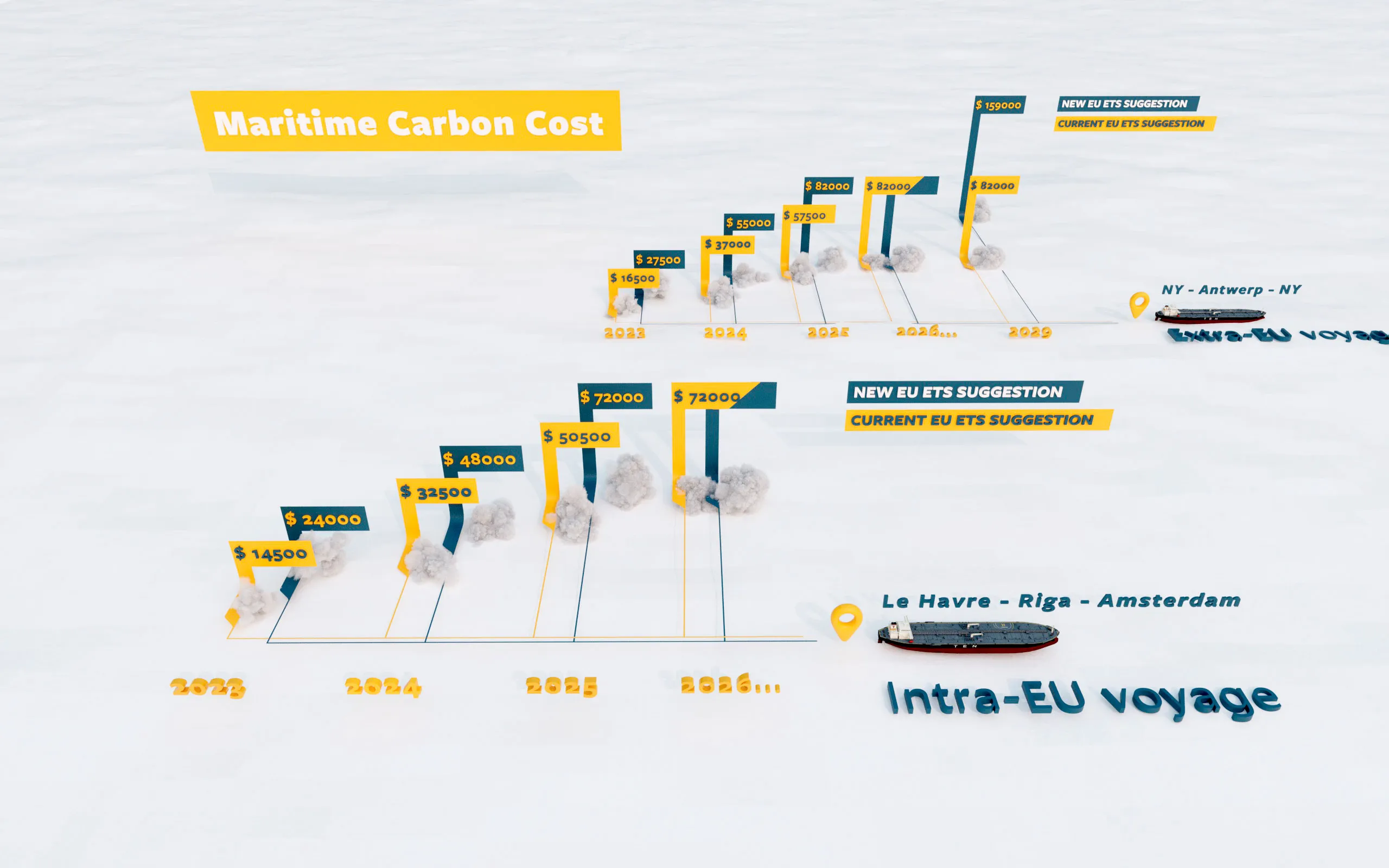Lorem ipsum dolor sit amet, consectetur adipiscing elit. Suspendisse varius enim in eros elementum tristique. Duis cursus, mi quis viverra ornare, eros dolor interdum nulla, ut commodo diam libero vitae erat. Aenean faucibus nibh et justo cursus id rutrum lorem imperdiet. Nunc ut sem vitae risus tristique posuere.
There are currently two suggested versions of how the maritime sector should be included in the EU ETS. We compare the two versions to demonstrate how each of them would the impact freight costs.
When the European Commission presented the “Fit for 55” package in July 2021, including the maritime sector in the European Emissions Trading System (ETS) was one of the measures suggested to decarbonise the maritime industry. The ETS proposal presented by the Commission in July has the potential to greatly influence freight rates. Now new suggestions made by the European Parliament’s rapporteur Peter Liese could influence the freight costs even more.
The Liese suggestions that would influence the maritime carbon cost the most
How would the new ETS suggestions impact freight costs
Below we compare the EU Commission’s current version to the new suggestions made by Liese and demonstrate the different carbon cost impact of the the two versions.

Illustration of the potential added carbon cost to two MR voyages in the two different scenarios
If the new suggestions are implemented, it would result in a substantially higher carbon cost of both internal and global EU voyages. The suggested acceleration of the phase-in period could increase freight costs of a global MR voyage * by USD 82 000 in 2025. The inclusion of 100% of the emissions from global EU voyages in 2029 would lead to carbon cost of USD 157 500. In the intra-EU example**, the phase-in period could increase freight costs by USD 72 000 in 2025.
The calculations
The carbon price is based on the average February 2022 settlement price of the European Emission Allowances February in the EEX spot market (90,73 EUR) and on a EUR/USD exchange rate of 1.13.
Emissions are calculated using The Siglar Carbon Estimator.
**Emissions from the internal EU voyage example is based on a modern MR vessel (max 5 years) loading 37000 tonnes of gasoline in Riga, discharging in Amsterdam, ballasting from Le Havre. It includes emissions from ballast leg, laden leg and port stay in Riga (2 days) and Amsterdam (2 days). Total and eligible emissions from entire voyage: 700 tonnes of CO2.
*Emissions from the extra-EU voyage example is based on a modern MR vessel (max 5 years) loading 37000 tonnes of gasoline in Antwerp, discharging in New York, ballasting from NY. Total emissions include emissions from ballast leg, laden leg and port stay in Antwerp (2 days) and New York (3 days). Emissions from loading and discharge in non-EU ports are not eligible for EU ETS. Total emissions from entire voyage: 1700 tonnes of CO2. Eligible emission from voyage: 800 tonnes of CO2 in 2026, 1550 tonnes of CO2 in 2029.

When the European Commission presented the “Fit for 55” package in July 2021, including the maritime sector in the European Emissions Trading System (ETS) was one of the measures suggested to decarbonise the maritime industry. The ETS proposal presented by the Commission in July has the potential to greatly influence freight rates. Now new suggestions made by the European Parliament’s rapporteur Peter Liese could influence the freight costs even more.
The Liese suggestions that would influence the maritime carbon cost the most
How would the new ETS suggestions impact freight costs
Below we compare the EU Commission’s current version to the new suggestions made by Liese and demonstrate the different carbon cost impact of the the two versions.

Illustration of the potential added carbon cost to two MR voyages in the two different scenarios
If the new suggestions are implemented, it would result in a substantially higher carbon cost of both internal and global EU voyages. The suggested acceleration of the phase-in period could increase freight costs of a global MR voyage * by USD 82 000 in 2025. The inclusion of 100% of the emissions from global EU voyages in 2029 would lead to carbon cost of USD 157 500. In the intra-EU example**, the phase-in period could increase freight costs by USD 72 000 in 2025.
The calculations
The carbon price is based on the average February 2022 settlement price of the European Emission Allowances February in the EEX spot market (90,73 EUR) and on a EUR/USD exchange rate of 1.13.
Emissions are calculated using The Siglar Carbon Estimator.
**Emissions from the internal EU voyage example is based on a modern MR vessel (max 5 years) loading 37000 tonnes of gasoline in Riga, discharging in Amsterdam, ballasting from Le Havre. It includes emissions from ballast leg, laden leg and port stay in Riga (2 days) and Amsterdam (2 days). Total and eligible emissions from entire voyage: 700 tonnes of CO2.
*Emissions from the extra-EU voyage example is based on a modern MR vessel (max 5 years) loading 37000 tonnes of gasoline in Antwerp, discharging in New York, ballasting from NY. Total emissions include emissions from ballast leg, laden leg and port stay in Antwerp (2 days) and New York (3 days). Emissions from loading and discharge in non-EU ports are not eligible for EU ETS. Total emissions from entire voyage: 1700 tonnes of CO2. Eligible emission from voyage: 800 tonnes of CO2 in 2026, 1550 tonnes of CO2 in 2029.
